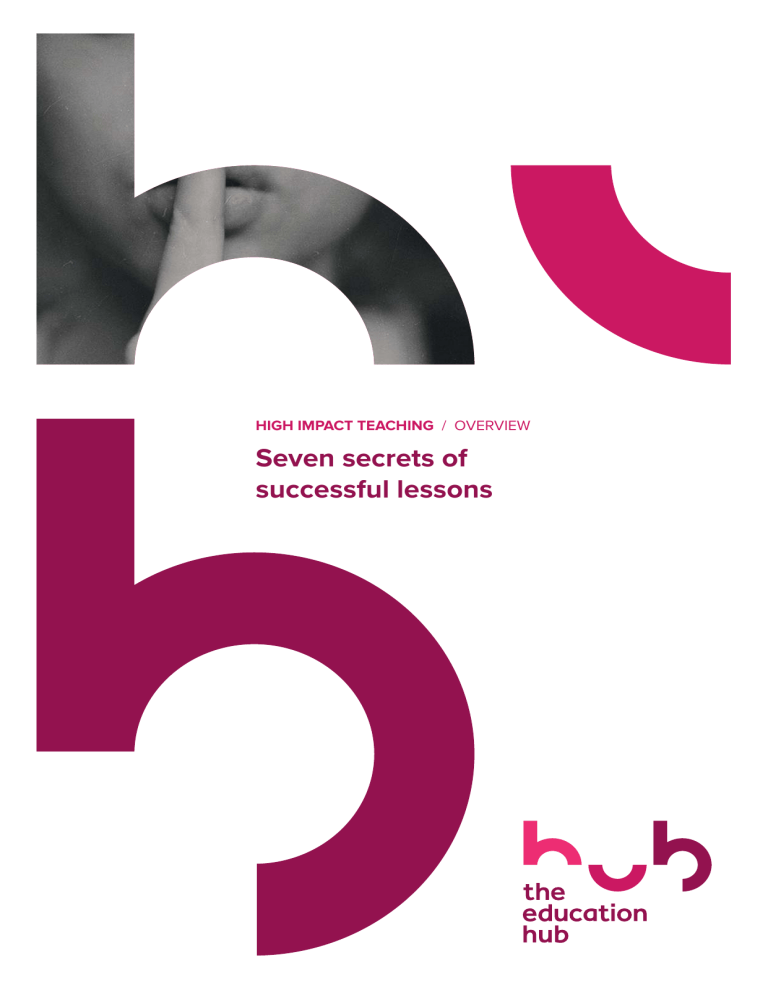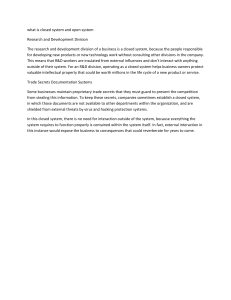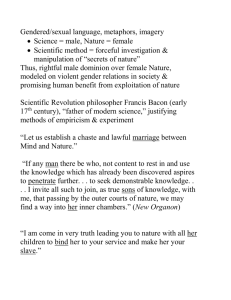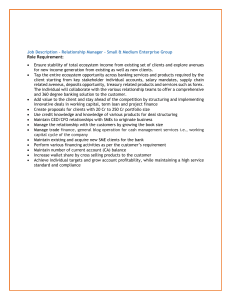7 Secrets of Successful Lessons: High Impact Teaching Overview
advertisement

HIGH IMPACT TEACHING / OVERVIEW Seven secrets of successful lessons HIGH IMPACT TEACHING / OVERVIEW Seven secrets of successful lessons 4 5 6 7 8 9 10 11 11 11 12 Seven components of successful lessons diagram Orienting Assessing Structuring Questioning Teaching and modelling strategies Application Interactions Teacher-student interactions Student-student interactions Sources To explore more research guides, visit www.theeducationhub.org.nz 2 © The Education Hub HIGH IMPACT TEACHING / OVERVIEW Seven secrets of successful lessons Summary There are lots of ways to be an effective teacher and to structure lessons and learning activities to achieve maximum impact and outcomes for your students. However, research tells us that there are certain things that you can do when planning and teaching lessons that will promote students’ learning. You will probably do many of these things without even thinking. However, it’s important to take time to reflect on your current practice and to ask yourself how you might be able to improve the learning experience of your students. Consider the different components of a successful lesson below – which do you incorporate well, and which might you strengthen? To explore more research guides, visit www.theeducationhub.org.nz 3 © The Education Hub HIGH IMPACT TEACHING / OVERVIEW Seven secrets of successful lessons Seven secrets of successful lessons Seven components of successful lessons diagram Orienting What is it? What is it important for? Explaining the objectives and success criteria of Motivation and self-regulation. task/lesson. Ongoing adjustments to teaching during a lesson. Gathering information to actively manage and Assessing understand students’ learning and evaluate Ongoing adjustments to teaching during a lesson. teaching. Structuring Structuring and highlighting material through Memorisation of information and its apprehension overviews and outlines, clear transitions and as an integrated whole. regular reviews throughout lesson. Questioning Directing feedback at the right level. Higher achievement. Asking questions which open up the dialogue Verbalising thinking , checking students’ in the classroom and which unpack students’ understanding and scaffolding. understandings. Modelling Teaching students to use and/or develop Higher-order thinking, metacognitive (selecting strategies for solving problems. and monitoring strategies) and self-regulation skills. Application Providing practice activities while monitoring Mastery and fluency of knowledge and skill progress and providing feedback. development, and understanding of abstract concepts. Focusing teaching interactions on creating a Improved engagement rates and reduced knowledge- and learning-centred, assessment-rich disruption. environment accompanied by high expectations. Interactions Safety and respect for learning. Higher achievement. Students tutoring and helping each other, and giving feedback to facilitate each other’s learning. Cognitive restructuring. Rehearsal and deliberate practice. Adapted from Creemers & Kiriakides, 2006 To explore more research guides, visit www.theeducationhub.org.nz 4 © The Education Hub HIGH IMPACT TEACHING / OVERVIEW Seven secrets of successful lessons ORIENTING Orienting involves letting students into the secret of the lesson – what is going to occur and, most importantly, what they are expected to learn. The idea is that if you highlight what students will be learning they can focus their attention on the teaching in line with this learning goal. But it is not just students who benefit from clear objectives. As the teacher, if you are focused on what students are intended to learn, and not on implementing the activites you planned, then you can modify and adapt your teaching during a lesson to best help students achieve this learning. How to orient your class to learning • Make sure you always explain the objectives for a particular task, lesson or series of lessons. • Plan backwards by determining what success of a lesson should look like first before planning activities. • Clearly describe what the achievement of the objectives would look like. Provide success criteria by which the students can know they have learnt what they were expected to. Success criteria are specific and measurable and allow students to easily check whether they have included all the elements of a persuasive conclusion in their writing, or that they used defining characteristics to describe a geographical area. Success criteria also help you convey your high expectations of students that they are going to succeed in a particular learning problem. • When setting success criteria, use the following sentence: “Students Will be Able to …” Two ideas for strengthening orienting in your teaching • Offer students various pathways to achieving a challenging goal and discuss these with students • Challenge students to identify why an activity takes place in the lesson? To explore more research guides, visit www.theeducationhub.org.nz 5 © The Education Hub HIGH IMPACT TEACHING / OVERVIEW Seven secrets of successful lessons ASSESSING Assessment information enables you to monitor your students’ path to success in the learning intention, and to provide feedback that is at the right level to assist students with comprehending content or developing intended strategies. Students too can better regulate their own learning if they can use information from assessments to understand their learning gains. Assessment also offers an opportunity for you to learn about the effects of your teaching, and to plan changes and adjustments to your teaching plans. It alerts you to situations where previous routines are not working well and in which you perhaps need different solutions. In addition, assessing can convey a message to your students that you are interested in how their learning is going (not just concerned with proceeding with your planned teaching) which can enhance your students’ enthusiasm and heighten their commitment to meeting the learning goal. Assessment needn’t be formal, just talking with and listening to your students is an excellent way to gather information. (What questions do they ask? How do they explain their thought processes? What ideas do they have?) Try to ensure you offer rich opportunities for dialogue. Questions to ask to improve your assessing a How many different ways can you collect assessment information, outside of testing? Have you tried these ideas? • Encouraging students to think aloud? (How do you make your classroom a safe place to do so?) • Inviting students to answer their peers’ questions? How do they do that? • Involve students in self-assessment by asking them to evaluate their own progress and discuss gains in learning with their peers? • After instruction, can a formative assessment such as an exit slip [link] be used to help students identify what they have learned well and what they still need to work on, and point them to corrective activities to help them? a Can you make feedback an opportunity for further instruction rather than an evaluation of correctness? Do you know how to focus feedback on the task and goals, and on what students needs to do to improve their understanding, strategy or skill? a Can an assessment opportunity also enable you to enquire into the success of your own teaching? For example, could you administer assessment at the beginning and end of the lesson or activity to measure learning gains as a result of that lesson? To explore more research guides, visit www.theeducationhub.org.nz 6 © The Education Hub HIGH IMPACT TEACHING / OVERVIEW Seven secrets of successful lessons STRUCTURING When a teacher engages in structuring material, this means that material is clearly organised into progressive steps and framed in a way that reinforces the key ideas (link-direct instruction). While it is always good to provide examples and related content, structuring makes clear to your students what the take-home message is. How to structure your lesson Review and repetition are key to structuring your lesson for maximum learning. At the beginning of a lesson, review prior learning, including key concepts, ideas or strategies. Remind students what they (were expected to have) learned last lesson. Then outline today’s lesson, and tell students what they will learn. Stop regularly during each lesson to review what has been covered (tell students what they learned again). Link the next part of the lesson to the preceding part (“Now that you can appreciate [repeat the key idea]...” or “With this strategy [repeat it] under your belt...”). Keep stopping to look back and look forward. Finish the lesson by reviewing the main points and what has been learned. While this may sound repetitive and boring, it’s not. Structuring eliminates confusion and frustration as students are clear on what they need to learn and remember. Keep a quick, lively pace and your students will be impressed by how much learning ground you are covering! Why structuring works Structuring helps students to memorise information, primarily because structuring involves you in repeating and reviewing key concepts and ideas several times over a lesson. While we often get told it’s no longer necessary to memorise information because we always can just rely on Google without committing knowledge to our long-term memories, our working memories become overburdened and limit learning. For example, it would be very hard to progress in maths if we continually have to use a calculator to add 1+1. Or we would struggle in English if we did not know the meaning of some frequently used words. Structuring can also aid students in comprehending information as an integrated whole and in recognising relationships between parts. Structuring supports students to make sense out of what has been taught and eliminates confusion and frustration. How to improve your structuring Think about: • the key learning or information you want students to remember • which points in your lesson plan you can repeat it (think openings, transitions, reviews) • how you will review the key ideas and learning at the end of the lesson • how you can minimise students being distracted by unimportant details? For example, be cautious of open-ended activities, and asking students to do internet searches or create PowerPoint presentations • whether rather than opening the lesson with an attention-grabbing demonstration or idea, you could place this at the end of the lesson, to consolidate what has been learnt? How reflective of your main learning point is this activity, demonstration, or idea? To explore more research guides, visit www.theeducationhub.org.nz 7 © The Education Hub HIGH IMPACT TEACHING / OVERVIEW Seven secrets of successful lessons QUESTIONING Effective teachers ask lots of questions. And they ask the questions that are worth asking. Most classroom talk involves the teacher in asking questions of students, but sometimes these questions stick to a familiar pattern and are of limited value. For example: a teacher asks a question, a student responds with an answer, and the teacher evaluates the response, before asking the next question. This ‘initiation-response-evaluation’ exchange enables the teacher to dominate talking while students are reduced to giving lower-order cognitive responses involving the recall of facts or declarative knowledge. These patterns of interaction, usually not noticed by teachers, are not associated with the deep learning of cognitive change and concept development. They limit opportunities for students to discuss and begin to regulate their learning. What are effective questions? Effective questions open up dialogue with students. Dialogue offers important opportunity for formative assessment of students’ ideas and strategies. Effective questions are those that invite students to think — and give them time to think. They are ‘process questions’ which require lengthy answers and explanations. Single-answer or ‘product questions’ have their place too, but you should emphasise process questions. In order for other students to learn, make sure you acknowledge correct responses. Effective questioning involves follow-up questions to probe students’ thinking further. With the right kind of questions, you can help students to clarify and verbalise their thinking, while at the same time assessing their understanding and providing appropriate instructive feedback. Questions to ask yourself to improve your questioning a Are you able to break out of the initiation-response-evaluation cycle and foster sustained dialogue? a What kinds of thinking do your questions invite? a What kinds of question encourage higher-level thinking skills such as reflection, explanation or justification? a What kind of response to a student’s contributions encourage the student to continue talking? a Does discussion happen with the whole class, with small groups and with individuals? a Can you invite students to answer each other’s questions? To explore more research guides, visit www.theeducationhub.org.nz 8 © The Education Hub HIGH IMPACT TEACHING / OVERVIEW Seven secrets of successful lessons TEACHING AND MODELLING STRATEGIES Effective teachers help students use or develop strategies for solving different kinds of problems. They might clearly present strategies for students to learn, or they might invite students to share strategies and therefore promote the modelling of strategies in their classrooms. Students with an understanding of a range of strategies and how and when to use them can become self-regulating students that organise and evaluate their own learning. Teach students to use and/or develop their own strategies for solving different kinds of problems, including the problems of learning (how to avoid distractions, what to do when you get stuck, how to memorise information, etc.). How to model learning strategies A particularly important learning strategy to model is students’ ‘self-talk scripts’, as it has the highest impact on learning. Self-talk scripts teach students how to actively work with the material they are trying to learn. They involve students creating an internal dialogue with themselves about how they are approaching a particular topic, and the questions they are asking themselves as they engage with content. For example, outlining, organising, integrating and transforming, summarising and paraphrasing are shown to be the top strategies for engagement with content. Teaching and modelling strategies promotes higher-order thinking in students and helps them learn the metacognitive skills involved in selecting and monitoring strategies. With this in mind, it is important to teach students the ‘how’, ‘when’, ‘where’, and ‘why’ of strategy use. • Present opportunities to teach and model strategies in your lessons by focusing your teaching on problems. Use a problem to develop multiple perspectives and uncover issues, as well as to evaluate outcomes. • Teach students strategies for effective learning, such as how to set goals and plan how to achieve them, how to check and monitor progress while learning and how to assess the quality of their work. Use prompt sheets to remind students of questions to ask and things to think about. • Build into your teaching opportunities for students to re-look at their goals and to assess their progress to date. Make sure you talk with students about their goals and progress. • Focus your feedback on strategy use rather than correct answers, to provide another opportunity to revisit, discuss and revise strategies. How to improve teaching and modelling strategies • Experiment with reducing thinking load to allow students the mental space to explore using strategies. Examples: provide a worked example of a problem-statement and the appropriate steps to the solution, to focus on strategies rather than answers. Give the terms for a concept map to focus students on the organising and synthesising of the concepts, rather than content. • Find ways to cue metacognitive activities and reflection during tasks To explore more research guides, visit www.theeducationhub.org.nz 9 © The Education Hub HIGH IMPACT TEACHING / OVERVIEW Seven secrets of successful lessons APPLICATION In application, students apply the knowledge and skills they are learning in carefully devised practice activities which aim to improve their performance in the topics taught during the lesson. Practice enables students to review what they have learnt during instruction, to enhance mastery and gain fluency. Also, students’ understanding of a concept or strategy will improve with multiple and varied examples. This is not repetitive ‘drill and practice’, but the meaningful application of skills and concepts taught in order to develop mastery and fluency. It helps to show students the value of deliberate practice, in terms of the refinement of skills or speed of use. This is also not an opportunity to get on with some marking! It’s important that you circulate around the class, monitor progress and offer feedback as well as help. Timing of practice Research shows that opportunities for practice should be frequent but spaced out, and interspersed with other tasks and topics, rather than continuous. A gap between practice sessions, which allows for the forgetting and then reconstructing of skills or knowledge, aids long term retention (Coe et al., 2014). It is important to vary the contexts and types of task so that skills can be adapted to different situations and to aid their long-term retention. Students need to be able to apply their knowledge and skills in different contexts, in relation to different stimuli. One way to explore this with students is to present them with a task that is outside their realm of current application or performance level. How to improve application in your teaching • Encourage students to evaluate the impact of practice on a particular skill. • Use application tasks as starting points for the next step in learning. • Have students monitor and provide feedback to each other during the practice. To explore more research guides, visit www.theeducationhub.org.nz 10 © The Education Hub HIGH IMPACT TEACHING / OVERVIEW Seven secrets of successful lessons INTERACTIONS Teacher-student interactions Your interactions with students convey your expectations of them, so it’s important that you expect all students to succeed and do well in learning. Students that teachers expect to do well do achieve better [link to high expectation teaching] – so don’t let your expectations drop for any student or class. Aim to create an environment in which students share a sense of purpose and investment in the learning goals with you, and where they feel comfortable and safe to share the ups and downs of their learning journey. Research shows that low-achieving students who received instruction that challenged their thinking and experienced an emotionally supportive environment were able to narrow the achievement gap. Students who feel part of the class are more likely to engage in learning. Time spent managing disruptions will be reduced, leading to more teaching and learning per lesson. Student-student interactions An effective learning environment has plenty of positive reciprocal teaching among peers. By setting up co-operative learning situations, which research finds to be more effective than individualistic methods, you can teach students how to help, tutor and give feedback to each other. Students learn most by becoming their own teachers and teachers of others. Questions to ask yourself to improve interactions in your lessons a How often do you: • engage your class in productive talk about learning, and listen? • show interest in all ideas? • welcome errors, and encourage students to welcome errors, rather than trying to minimise or sweep over them to save face? • make learning collective and cumulative by building on students’ ideas? a Can you group students with different capabilities and understandings in collaborative tasks to encourage peer mediation? a How can you clearly structure opportunities for collaboration? a Have you tried using peer work for learning concepts, verbal problem solving, categorising, spatial problem solving, memory and guessing-judging-predicting? a What do you need to explicitly teach students, for them to take an active part in, or even lead, discussion, or be effective tutors for each other: to set mastery goals, monitor performance, evaluate outcomes and provide feedback. Finally, consider these questions to positively expand your expectations of students: a Can you abandon thinking about ability (and using ability groupings) and instead emphasise increased effort and progress? a Can you consciously seek to be surprised by students’ learning outcomes, to challenge your own expectations of students? To explore more research guides, visit www.theeducationhub.org.nz 11 © The Education Hub HIGH IMPACT TEACHING / OVERVIEW Seven secrets of successful lessons Sources: Creemers, B. P. M. & Kyriakides, L. (2006) Critical analysis of the current approaches to modelling educational effectiveness: The importance of establishing a dynamic model. School Effectiveness and School Improvement, 17(3), 347-366, DOI:10.1080/09243450600697242 Coe, R., Aloisi, C., Higgins, S., Major, L. E. (2014). What makes great teaching? Review of the underpinning research. Sutton Trust: London. Hattie, J. (2009). Visible learning: A synthesis of over 800 meta-analyses relating to achievement [Proquest Ebrary Central version]. Retrieved from http:// ebookcentral.proquest.com/lib/auckland/reader.action?docID=367685 Hattie, J. (2012). Visible learning for teachers: Maximising impact on learning [Proquest Ebrary Central version]. Retrieved from http://ebookcentral.proquest. com/lib/auckland/reader.action?docID=958163&ppg=158 Muijs, D., Kyriakides, L., van der Werf, G., Creemers, B., Timperley, H., & Earl, L. (2014). State of the art- Teacher effectiveness and professional learning. School Effectiveness and School Improvement, 25(2), 231-256, DOI:10.1080/09243453.2014.885451 To explore more research guides, visit www.theeducationhub.org.nz 12 © The Education Hub



